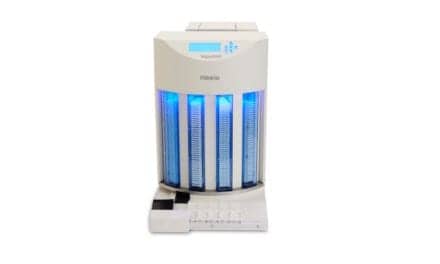Kinetic River Corp., a leader in advanced flow cytometry technologies, announced today it has been awarded a Phase II Small Business Innovation Research (SBIR) grant funded by the U.S. National Institutes of Health (NIH). The competitive $2.5-M grant was awarded by the National Institute of General Medical Sciences (NIGMS), which fosters development of innovative biomedical platforms. This is the fifth SBIR award received by Kinetic River to date and supports the company’s industry-leading development of an autofluorescence-free cytometry platform for enhanced analytical sensitivity.
Flow cytometry, the fluorescence-based high-speed identification and characterization of cells, is a ubiquitous technique with research and clinical applications ranging from oncology to immunology, cell biology, and infectious disease diagnostics. As with all analytical techniques, the sensitivity of flow cytometry is subject to limitations due to background noise in the measurement. One major source of background noise is “autofluorescence”: fluorescence intrinsic to a cell that obscures the signal from the added fluorescent markers used to label cells in a sample, making it hard or impossible to characterize certain types of cells. Existing efforts by cytometrists to handle autofluorescence pose unsatisfactory tradeoffs, impairing sensitivity or making certain detection channels unusable altogether.
The NIH-funded Phase I project Kinetic River completed in 2020 demonstrated the ability of its autofluorescence-free cytometry platform, “Colorado,” time-resolved technology to automatically remove autofluorescence background from cell measurements. This new award enables expansion of that effort into product development and commercialization. By performing fluorescence measurements in the time domain, the Colorado platform can distinguish autofluorescence background from the fluorescent signals of added cell markers, even when those emissions have completely overlapping spectra. This results in a radical increase of sensitivity of flow assays for certain cell types.
“We couldn’t be happier with the incredible support of NIGMS and the NIH,” says Giacomo Vacca, PhD, president of Kinetic River. “Their continuing underwriting of research and development in biomedicine has allowed us to move aggressively from concept to engineering. Thanks to their multiple awards, our [autofluorescence-free ] cytometry technology platform is now solidly established, and with this grant we are shifting into the product and application development phase.” Vacca adds that biological validation of the Phase II of the autofluorescence-free cytometry effort will focus on improving the sensitivity of assays used to characterize samples from patients with Acute Myeloid Leukemia, a type of blood cancer.
Several leaders in the field expressed support for the awarded project. “Single-cell technology has evolved tremendously in the last 20 years, leading to dramatic steps forward in our understanding of biology and disease,” says Pratip K. Chattopadhyay, PhD, of Talon Biomarkers and a consultant on this project. “[Autofluorescence-free] cytometry is another step forward in this evolution, and is likely to offer real advantages over other platforms. Kinetic River is poised to demonstrate this quickly with their Phase II SBIR award.”
Christopher Bare, assistant professor at the Icahn School of Medicine at Mount Sinai, who is not involved with the project, says “Intrinsic cellular fluorescence fundamentally reduces the dynamic range of any currently available system when measuring any biological material.” Prof. Bare added, “The Colorado [autofluorescence-free ] technology really has the potential to reveal the invisible in our samples and dramatically improve cell classification methods. I’m pretty excited!”
The time-resolved cell analysis technology developed at Kinetic River has applications beyond automated autofluorescence removal, including compensation-free flow cytometry (the subject of another NIH-funded Phase II SBIR project recently completed by Kinetic River) and highly multiparametric flow cytometry.
Featured Image: Leukemia is a blood cancer that can take many forms. In Acute Myeloid Leukemia (AML), an aggressive and often fatal form, myeloid cells (purple) grow out of control, crowding out red blood cells (pink) and causing severe health problems such as anemia and bleeding disorders. The effort funded by the latest NIH award to Kinetic River is aimed in part at improving the characterization of samples from AML patients. Image: “Acute Promyelocytic Leukemia, Marrow Aspirate” by euthman, CC BY 2.0.





